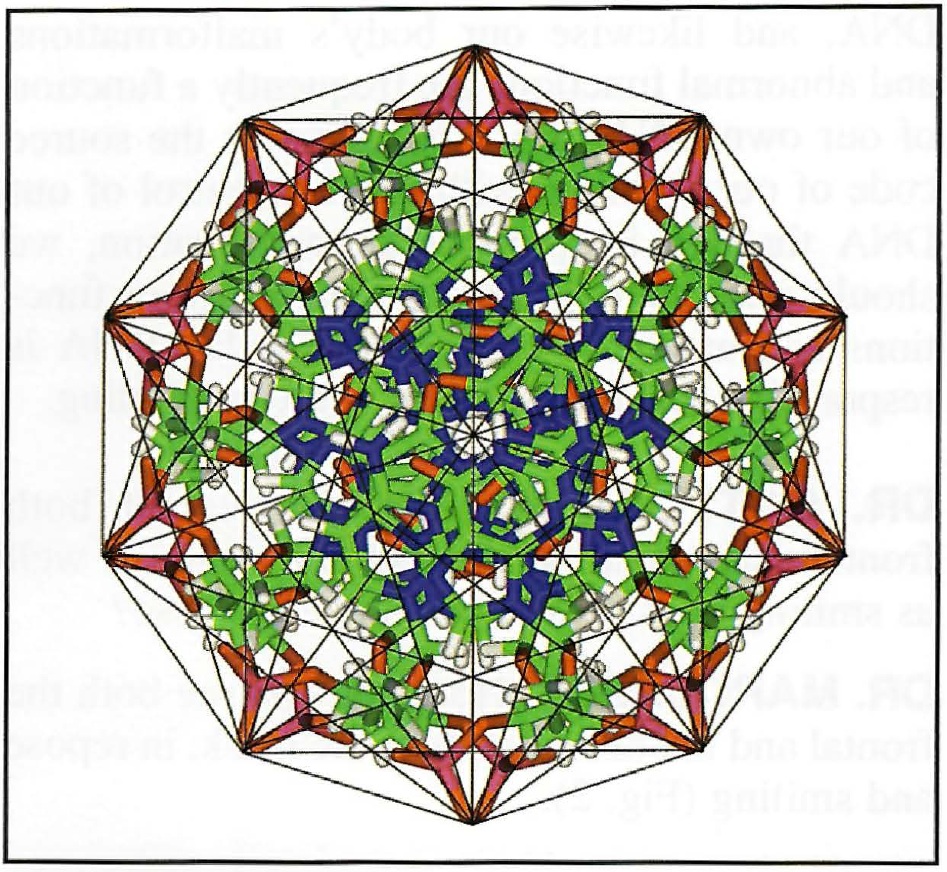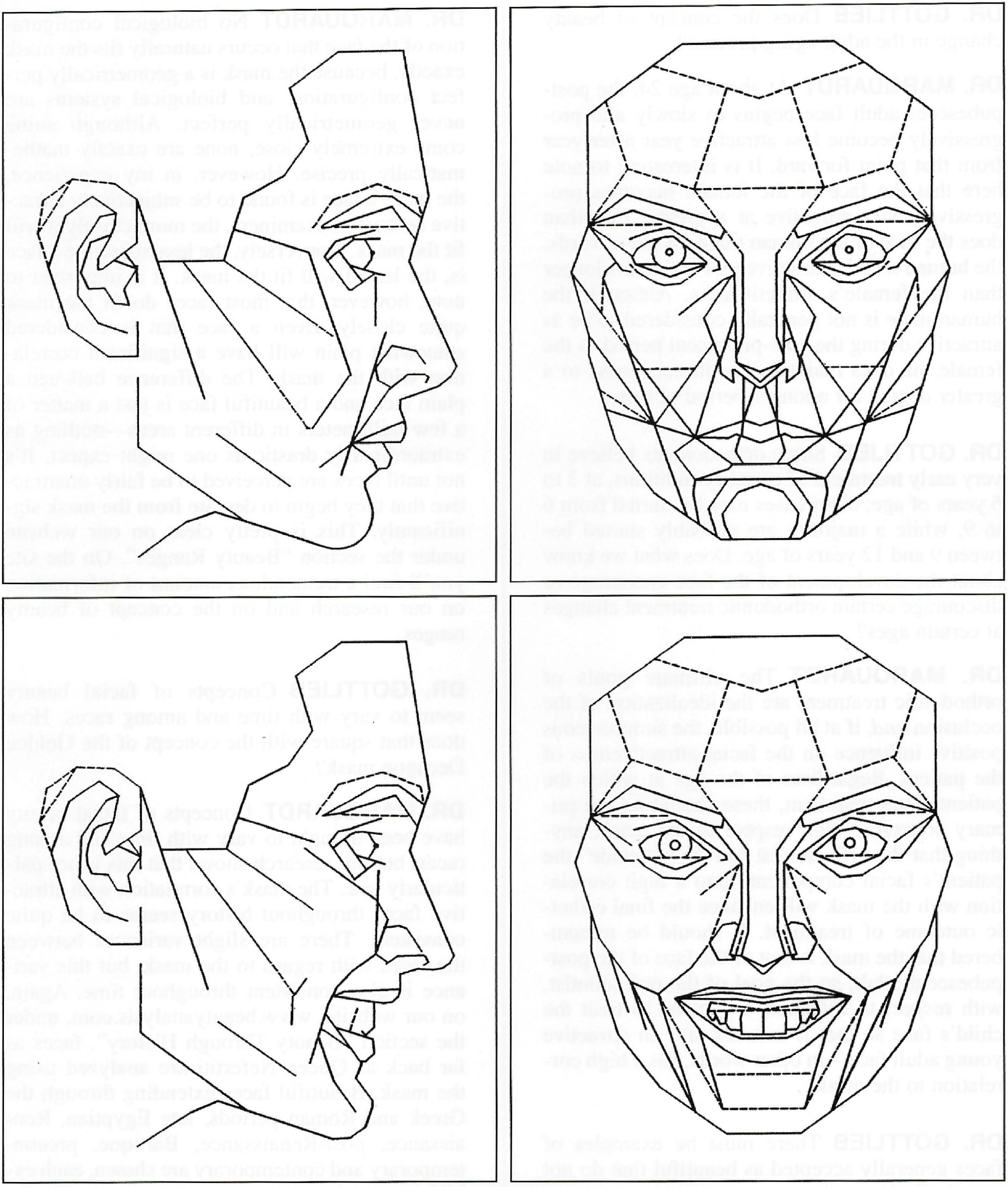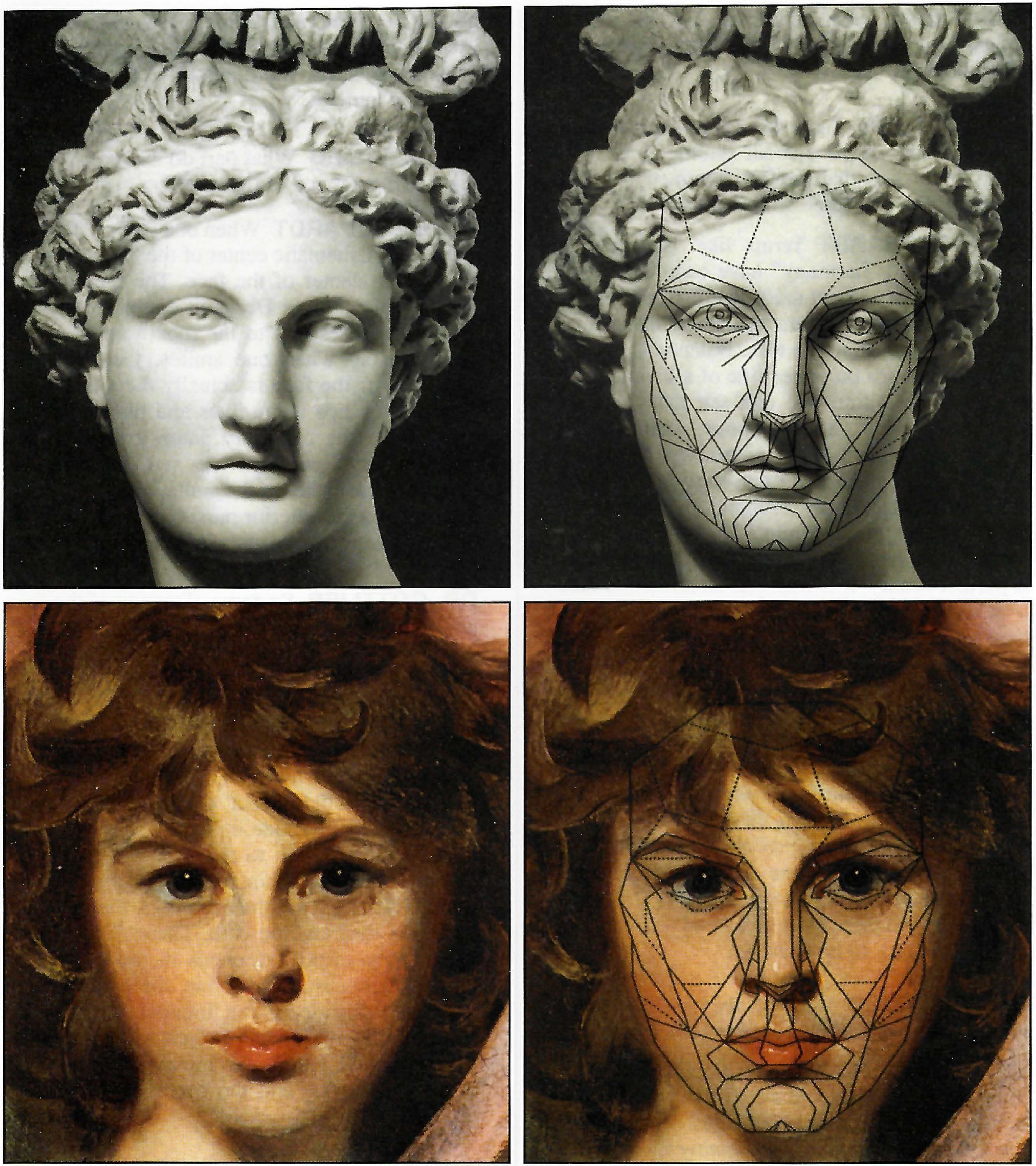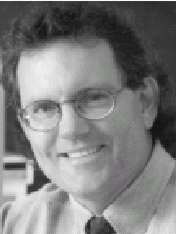JCO Interviews Dr. Stephen R. Marquardt on the Golden Decagon and Human Facial Beauty
DR. GOTTLIEB Steve, you appeared on a recent television documentary series, The Human Face, in a section called "Beauty", and presented a Golden Decagon mask that you have devised from the Golden Ratio. What is the Golden Ratio?
DR. MARQUARDT The Golden Ratio is a ratio found in nature and design that measures 1:1.618. It has been called the Fibonacci Ratio or Phi Ratio and, sometimes, the divine ratio. It is also referred to as the Golden Section or Phi Section.
DR. GOTTLIEB Many historic figures--Pythagoras, Plato, Euclid, da Vinci, Durer, and Mozart, to name a few--have believed the Golden Ratio represented perfect harmony in nature and in design. Is there evidence for such a phenomenon?
DR. MARQUARDT It does seem to occur throughout nature in many biologic systems, including flowers and the leaf divergence from a stem in plants, and particularly in humans. For example, the width of the nose to the width of the mouth is a ratio of 1:1.618 in a beautiful face. In an ideal dentition, the width of the maxillary central incisor is 1.618 times the width of the maxillary lateral incisor. In an ideal human body--for example, Leonardo da Vinci's Vitruvian Man (or "Man in a Circle")--the distance from the bottom of the foot to the navel is 1.618 times the distance from the navel to the top of the head, and the distance from the navel to the thyroid cartilage, or Adam's apple, is 1.618 times the distance of the thyroid cartilage to the top of the head.
Similar articles from the archive:
DR. GOTTLIEB You believe there is a mathematical, biological basis for human attractiveness in the Golden Ratio?
DR. MARQUARDT A famous platitude is that "beauty is in the eye of the beholder", and to a great extent that is true. A man may find a Ferrari automobile extraordinarily beautiful, where a woman might find it very unattractive; a woman might find a particular dress very beautiful, where a man may have totally ambivalent feelings about it. On the other hand, when it comes to facial attractiveness, there does seem to be a universal perception of characteristics of the form or shape of the face that are found attractive, and this attractive-face concept seems to be not only universal within one culture, but universally cross-cultural, regardless of other parameters, including birth rank, age, sex, etc. This universal perception of attractiveness appears to have a biological basis.
DR. GOTTLIEB Why did you create the Golden Decagon mask?
DR. MARQUARDT I have often been given credit for creating the Golden Decagon mask. However, I really have to say that I didn't create it, but rather discovered it. We now believe that this mask is an archetypal or instinctual pattern in our brain which is present before we are born and is with us throughout our lifetime. I originally was looking to try to answer the question, "Is beauty quantifiable?" That is, is there an idealistic or idealized form of the face which is universal with regard to a perception of attractiveness? The vast majority of people I questioned regarding this concept felt that beauty was not understandable or quantifiable, and something that we might never really comprehend to any degree. However, a few throughout history, including the artist Sir Joshua Reynolds and others, have felt that beauty probably is understandable and quantifiable to some extent. The reason I was searching for a quantifiable parameter for attractiveness myself was to better understand beauty, because as a facial reconstructive surgeon, a great deal of my surgical skill is used not only to correct functional facial deformities, but also to help correct esthetic deformities. Without a clear understanding of what beauty is, it's very difficult to have an appropriate or meaningful goal when one is correcting an esthetic deformity.
DR. GOTTLIEB That would apply to orthodontists as well.
DR. MARQUARDT Absolutely.
DR. GOTTLIEB How did you develop the mask?
DR. MARQUARDT I began merely studying faces of professional models and movie stars. By virtue of the fact that they get paid for being attractive, they seemed to be a good group to study to ascertain if there were some recurrent theme in attractive faces. I initially studied them with regard to any similarities they might have, and found that the Golden Ratio did seem to occur in the faces of these attractive people much more often than in the faces of less attractive individuals. There had been little success in multiple previous attempts to use the Golden Ratio to describe the attractive face, primarily because no generalized recurrent theme was found in the face.
DR. GOTTLIEB Why was that?
DR. MARQUARDT The big problem was that limited areas of the face could be described in linear fashion as carrying a 1:1.618 ratio, but this was all pretty much one-dimensional. No one had ever successfully described any part of the face or the entire face in any way in a two-dimensional configuration. My first major breakthrough was the realization that the visual perception of the face is really two-dimensional, and that if there were going to be some kind of a recurring theme in the face that was mathematical, it would most likely be two-dimensional, rather than one-dimensional. The simplest configuration that describes the Golden Ratio in two dimensions is an acute Golden Triangle with sides of 1.618 and a base of 1, or an obtuse Golden Triangle with a base of 1.618 and sides of 1. Together these elements form a Golden regular pentagon, and the regular pentagon itself, if duplicated, inverted, and superimposed on itself, forms the Golden Decagon--a regular vertex radial decagon. I must admit it took quite some time for my thinking to evolve from the Golden Section line into the two-dimensional complex configuration of the Golden Decagon, but once that was established, then the rest of the facial configuration was constructed fairly rapidly.
DR. GOTTLIEB For a long time the Golden Divider, which is a double caliper set to the Golden Ratio, was used to identify Golden relationships. What is the advantage of the mask over the divider?
DR. MARQUARDT The Golden Divider is very helpful to establish and understand linear relationships, but to really understand two-dimensional Phi harmony and Phi relationships, particularly in a face, it's necessary to use the Phi mask or at the very least the Phi decagon, which is the ultimate representation of the Phi Ratio as it occurs in the face in two dimensions.
DR. GOTTLIEB Are you developing a three-dimensional mask?
DR. MARQUARDT We are actually working on constructing the 3D versions of the masks at this time. For both the repose and smiling expressions, we already have the mask in two views (frontal and lateral). With two views of an object you can construct the third view, and with all three views you can construct a three-dimensional model. So with the two views of each expression already defined, we are well on our way to the 3D construction.
DR. GOTTLIEB One of the intriguing things about the Golden Decagon matrix is its relationship to DNA. If, as you say, the Golden Ratio is in the DNA structure, are the beauty and harmony in nature, including the structure of the human body and face, genetically determined according to the Golden Ratio?
DR. MARQUARDT As can be seen on our website, www.beautyanalysis.com, the Golden Decagon configuration is fairly complex geometrically, and the DNA molecule (particularly the "B" DNA molecule, which is the most common DNA seen in biologic systems) in cross-section exactly matches the Golden Decagon geometric configuration (Fig. 1). This is probably because the DNA, needing to replicate itself by increasing in size at a constant ratio, ad infinitum without deviation, appears to call upon the mathematics of the Golden Section, which itself is the only mathematical configuration that can duplicate itself ad infinitum without variance. Because both the DNA molecule and the Golden Decagon have this property, this is the most likely reason that the DNA follows the Golden Section geometrically. The research we've done so far seems to strongly indicate that the DNA structure, which is the determinant of the body and face construction, is built upon the Decagon complex, which in turn is built upon Phi or the Golden Section. We now feel that the Phi mask or Golden mask is a genetically encoded configuration or archetype which is basically encoded in our genetic material and passed on from generation to generation for recognition of our own species.

Fig. 1 Golden Decagon (black) overlaid on cross-section of B-DNA molecule (color).
DR. GOTTLIEB Is it science fiction to think that some of the more serious departures from facial and bodily beauty and harmony may be improved with DNA modification?
DR. MARQUARDT DNA is the basis for all life. It is the source code from which we, and everything within us, is made. Our body's potentially ideal form and function are a product of our DNA, and likewise our body's malformations and abnormal functions are frequently a function of our own DNA. Since our DNA is the source code of our creation, with greater control of our DNA through its purposeful modification, we should ultimately be able to control those functions and anatomic configurations that DNA is responsible for manipulating and constructing.
DR. GOTTLIEB You have developed both frontal and lateral versions of the mask, as well as smiling ones. Could you show us those?
DR. MARQUARDT Here you can see both the frontal and lateral versions of the mask, in repose (Fig. 2A), and smiling (Fig. 2B).

Fig. 2 Golden Decagon masks (repose and smiling).
DR. GOTTLIEB How should the masks be used?
DR. MARQUARDT The mask really describes the idealized form of the face. The ideal size of the face is approximately 1/7 to 1/8 of body height, which has been known since the first Greek sculptors presented this concept, and has been used ever since. On the other hand, there has never been a clear understanding or any quantification of the ideal shape or form of the face or its components, including the nose, eyes, lips, etc. I believe these masks are based on the first concept that truly mathematically quantifies the idealized face and its frontal and lateral views, both resting and smiling.
DR. GOTTLIEB How do you then apply that information?
DR. MARQUARDT The application for this information or technology would be in any area where idealized facial configurations are important, whether it be in medicine, in surgical applications of reconstructive procedures of the face; in orthodontics, for diagnosing variations from ideal and treatment planning their corrections; in art, whether it be painting or sculpture; and in the graphic arts, to modify and adjust faces to increase their visual perception of attractiveness. Additionally, the technology can be used in per- sonal identification and security programs, where any face could be compared to the mask and this comparison used as a unique personal "fingerprint" of the individual's face. Even genetically identical twins, under close analysis, have slight variances in their facial configurations. There are quite a few other applications, including biology, psychology, and anthropology, but these are some of the main ones.
DR. GOTTLIEB Does the Golden Decagon apply to the faces of children?
DR. MARQUARDT The Golden Decagon mask that has been presented at this point is that of the post-pubescent female adult, ranging from about 14 to 24 years of age. There is a mask for the young child, and it is somewhat of a slight variation from the post-pubescent adult mask, but is distinctly different in several ways. As anybody in the field of child development can attest, the face distinctly changes between the ages of approximately 2 and 14. The mask of a child between the ages of approximately 6 months and 2 years has a high degree of attraction for adults for the purposes of creating a nurturing behavior in adults toward that child. As the child increases in age, the face becomes less like that face, becoming relatively less attractive with age. For example, a 2-year-old is generally found to be more attractive than a 4-year-old. Most 4-yearolds are found to be more attractive than 6-yearolds, most 6-year-olds more attractive than 8- year-olds, and most 8-year-olds more attractive than 10- or 11-year-olds. At this point, however, attractiveness changes, and between the ages of approximately 11 and 14, the attractiveness increases tremendously. By 14, the face has metamorphosed into that of the pubescent adult. This matured face is generally quite attractive, not in a nurturing way for parents, but in a sexual attraction way for a mate. So while the mask of the child age 6 months to 2 years is significantly different from that of the post-pubescent adult, both are highly attractive, but in very different ways for their different biological purposes.
DR. GOTTLIEB Does the concept of beauty change in the adult aging process?
DR. MARQUARDT At about age 24, the postpubescent adult face begins to slowly and progressively become less attractive year after year from that point forward. It is interesting to note here that the face of the female becomes progressively less attractive at a greater rate than does the face of the human male. In other words, the human male's attractiveness maintains longer than the female's attractiveness. Although the human male is not generally considered to be as attractive during the post-pubescent period as the female, he does maintain his attractiveness to a greater degree for a longer period of time.
DR. GOTTLIEB Some orthodontists believe in very early treatment of certain conditions, at 3 to 6 years of age; other cases may be started from 6 to 9, while a majority are probably started between 9 and 12 years of age. Does what we know about the development of the face encourage or discourage certain orthodontic treatment changes at certain ages?
DR. MARQUARDT The ultimate goals of orthodontic treatment are the idealization of the occlusion and, if at all possible, the simultaneous positive influence on the facial attractiveness of the patient. Regardless of the age at which the patient starts treatment, these should be the primary concerns. With respect to the mask, anything that the orthodontist can do to "guide" the patient's facial components into a high correlation with the mask will enhance the final esthetic outcome of treatment. It should be remembered that the mask is that of the face of the postpubescent adult, so the goal of the orthodontist, with respect to esthetics, would be to treat the child's face so that it matures into an attractive young adult face--in other words, has a high correlation to the mask.
DR. GOTTLIEB There must be examples of faces generally accepted as beautiful that do not exactly fit the mask.
DR. MARQUARDT No biological configuration of the face that occurs naturally fits the mask exactly, because the mask is a geometrically perfect configuration, and biological systems are never geometrically perfect. Although some come extremely close, none are exactly mathematically precise. However, in my experience, the more a face is found to be subjectively attractive by human examiners, the more closely it will fit the mask. Conversely, the less attractive a face is, the less it will fit the mask. It is important to note, however, that most faces do fit the mask quite closely. Even a face that is considered somewhat plain will have a significant correlation with the mask. The difference between a plain face and a beautiful face is just a matter of a few millimeters in different areas--nothing as extraordinarily drastic as one might expect. It's not until faces are perceived to be fairly unattractive that they begin to deviate from the mask significantly. This is pretty clear on our website under the section "Beauty Ranges". On the site you'll find a tremendous amount of information on our research and on the concept of beauty ranges.
DR. GOTTLIEB Concepts of facial beauty seem to vary with time and among races. How does that square with the concept of the Golden Decagon mask?
DR. MARQUARDT Concepts of facial beauty have been thought to vary with time and among races, but our research shows that this is not particularly true. The mask's correlation with attractive faces throughout history seems to be quite consistent. There are slight variances between the races with regard to the mask, but this variance is also consistent throughout time. Again, on our website, www.beautyanalysis.com, under the section "Beauty Through History", faces as far back as Queen Nefertiti are analyzed using the mask. Beautiful faces extending through the Greek and Roman periods, late Egyptian, Renaissance, post-Renaissance, Baroque, pre-contemporary and contemporary are shown, each exhibiting a high correlation with the mask (Fig. 3). This is pretty clear evidence that the mask appears to consistently fit attractive faces throughout history.

Fig. 3 Application of Golden Decagon mask to Greek and Romantic concepts of facial beauty.
DR. GOTTLIEB There has been some discussion in dental esthetics about symmetry vs. balance. Some say that perfect symmetry is not beautiful. Do you agree with that concept?
DR. MARQUARDT Terms like "symmetry", "balance", and "harmony" have been used over and over again without much distinction for their actual definitions. Symmetry can be defined as mirror imaging about an axis. Balance is equality of magnitudes on either side of a division. So from this definition, we can see that absolute symmetry would have balance, but balance wouldn't necessarily have symmetry. Harmony, on the other hand, is the presence of recurring themes within an entity. Probably the term that's been equated most commonly with beauty is symmetry. It has been said that perfect symmetry is perfect beauty. It is true that an attractive face is relatively symmetric, but that doesn't mean that a symmetric face is necessarily attractive. For example, a face like Paulina Porizkova's, on the cover of this issue, is quite symmetric and quite beautiful at the same time. On the other hand, if you take a face like Alfred E. Neuman's from Mad magazine and make it perfectly symmetric, he doesn't become Paul Newman, he's just a symmetric Alfred E. Neuman. So symmetry doesn't necessarily predict attractiveness. A face doesn't have to have exactly perfect symmetry to be beautiful, but symmetry is an important factor, and there must be a good deal of symmetry for a face to be beautiful.
DR. GOTTLIEB Why is the smiling mask more attractive than the repose mask?
DR. MARQUARDT The smiling face has historically been considered more attractive than the repose face in almost all cultures. The smiling mask actually contains significantly more of the Golden Decagon elements than are found in the repose mask. This appears to be the reason that we find the smiling mask more attractive. The greater the number of Golden Decagon elements used in the construction of a facial configuration or expression, the more attractive that face will appear to humans.
DR. GOTTLIEB What part do the teeth play in the smiling version of the mask?
DR. MARQUARDT When one smiles, the geometric or mathematic center of the face is not the geographic center of the face. The face is constructed of multiple Decagon complexes which pretty much descend to the mouth and encircle the teeth, so when one smiles, the center of attraction of the face is actually the smile. This includes the lips themselves and their contents, particularly the maxillary anterior teeth. Since the maxillary central incisors and the lateral incisors are the center of the smile, one could actually say that the anterior maxillary teeth are really the center of the visual elements in the face.
DR. GOTTLIEB So some elements of the face are more critical than others?
DR. MARQUARDT The perception of the face is predicated on recognition of the different subcomponents of the face. The most important parts for facial recognition are contained within what is referred to as the "Internal Triangle". This is a triangle from the eyebrows to the chin--specifically, one encircling the eyebrows and extending down to the chin with the point downward at the chin. Contained within this Internal Triangle are the eyebrows, the eyes, the nose, the lips, and the chin. These elements are actually the critical elements in facial recognition. The cheeks, the jaw line, the hairline, etc., contained outside of the Internal Triangle are secondary elements and are not as important as the elements within the Internal Triangle for facial recognition and the perception of attractiveness.
DR. GOTTLIEB Can you picture ways in which an orthodontist could use the Golden Decagon mask?
DR. MARQUARDT The orthodontist can use the mask as a paradigm of the ideal, final esthetic result. Insofar as the orthodontist can change or modify the esthetics with treatment, he or she should be cognizant of the changes necessary to bring the facial soft tissues into as close an alignment with the mask as possible to effect an ideal esthetic, as well as functional, result. Treatment planning using growth forecasts and facial analyses are critical when treating children as they mature into the young adult stage of their life, and having an idealized goal such as the mask to treat toward, I believe, would give much more consistent and esthetic results at the end of treatment than is currently possible.
DR. GOTTLIEB Could children in an orthodontic practice use the mask to explore aspects of their own facial beauty?
DR. MARQUARDT Children can certainly apply the mask to their faces to explore the correlation of their faces with the mask, but it is unfair to judge a child's attractiveness or future attractiveness by applying the mask to them as a child, due to the variation of growth patterns and inconsistency of facial growth from one child to another. Most children do not match the mask particularly well before they are 14 or more years of age. I think after that age, however, the mask is a significant way for pubescent young adults to analyze their faces, and a guide for the orthodontist in deciding on a treatment plan that will effect the most positive esthetic change for them. In addition, I believe that growth forecasting before the age of 14 may be a valuable aid in helping the orthodontist determine how closely the child's face, with normal growth, might potentially match the mask by the time they are a young adult. With this information, the orthodontist can make necessary corrections to guide growth into a configuration that will match the mask as closely as possible by young adulthood. This is particularly true when surgery is contemplated along with orthodontic therapy.
DR. GOTTLIEB Thank you, Steve, for giving our readers a fascinating insight into the ingredients of human facial beauty.



